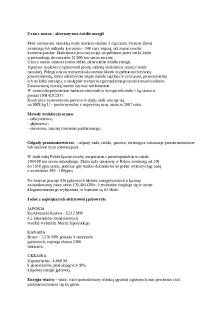Edspe - Chapter 4&5 PDF

| Title | Edspe - Chapter 4&5 |
|---|---|
| Course | (Dis)ability, Education, and the Arts |
| Institution | University of Washington |
| Pages | 8 |
| File Size | 95.6 KB |
| File Type | |
| Total Downloads | 31 |
| Total Views | 128 |
Summary
EDSPE Chapter 4&5 - Focuses on punishment and the types of behavior that is attached with punishment. Explains the factors the influence the effectiveness of punishment and the possible side effects. Addresses guidelines for use and ethical issues that may result, as well as two types of negative pu...
Description
Chapter 4&5 Thursday, January 18, 2018
2:37 PM
Chapter 4&5 Punishment is a consequence paired with a specific response. Behaviors are punished-not people Behaviors are reinforced-not people
Punishment has occurred when a response is followed immediately by stimulus change that decre the future frequency of a similar response Punishment Contingency- Positive Punishment is the presentation of an aversive stimulus that res in the decrease of the target behavior Penalty contingency (negative punishment) punishment)-- the response contingent removal of a reinforcer resulting in the decrease frequency of a behavior Positive Punishment Punishment-- presents a stimulus contingent on a target behavior Negative punishment punishment--terminates a stimulus that is already present contingent on a target behavio
Factors that influence the effectiveness of punishment -immediacy -intensity/magnitude -schedule -reinforcement of target or alternative behaviors Possible Side Effects: -emotional and aggressive reactions -escape and avoidance -behavioral contrast (target behavior could increase when the S^P is not present) -Punishment may involve modeling undesirable behavior -punishment reinforces the punisher Examples of Positive Punishment Interventions -Reprimands -contingent exercise-stairmaster for tv watched -overcorrection -restitution- restore and improve positive practice multiple trials
e
lts
-positive practice-multiple trials -contingent application of aversive (ex: electrical shock) Overcorrection: an example of positive punishment, contingent on inappropriate behavior, the person is required to engage in a mildly effortful response that more than corrects the challenging behavior
Guidelines for Use -select effective and appropriate punishers -use punishers of sufficient quality and magnitude -use varied punishers -timing-deliver punisher at the right time -be consistent -thin the punishment schedule -teach appropriate alternative -collect data Ethical Issues: -first do no harm -right to safe and humane treatment -least restrictive alternative -right to effective treatment -considerations: -higher intensity first (don’t teach satiation) -Must be designed and supervised by a well-trained professional behavior analyst -solid data should show that less drastic or less intrusive interventions will not work -Reinforcing an appropriate alternative behavior Two Types of Negative Punishment: -time out from positive reinforcement -response cost Important elements in Time Out -discrepancy between time in and time out -contingency and consistency -resultant decrease in target behavior -exclusionary vs non-exclusionary Tips for Using Time Out -define the Target Behavior -define where the TO will occur
Tips for Using Time Out -define the Target Behavior -define where the TO will occur -define how long TO will last -teacher implements TO immediately -no talking -teacher ends TO -return student to the activity that was happening before TO -take data -continue to reinforce Desirable Aspects of TO -easy to use -acceptable -effective -can be easily combined with other applications Response cost: a form of punishment in which the loss of a specific amount of reinforcements occurs contingent on a target behavior (fines, loss of privileges)
Desirable Aspect of Response Cost -effective -convenient -easily combined with other strategies Response Cost Methods -Fines -Bonus response cost -combining with positive reinforcement -combine with group contingency Using Response Cost Effectively -Determine target behavior -specify amount of fine -ensure reinforcement reserve -recognize potential for unplanned outcomes -implement consistently -keep records When you punish a behavior, you have to teach (via reinforcement), an appropriate alternative
Single Case Design Research -Independent variable-systematically manipulated by the experimenter. Often, the intervention. Changes in different phases of the intervention -Dependent variable-the same across all phases of the intervention. The behaviors that are measured -Each client serves as their own control -Replication is VERY important Baseline-treatment as usual Intervention- Independent variable Multiple Baseline Design- this design is used when teaching skills that you would not expect to reverse (language skills, play skills, self care skills) Three types of multiple baseline designs -settings -participants -behaviors...
Similar Free PDFs

Edspe - Chapter 4&5
- 8 Pages

Chapter 45- Esophageal
- 6 Pages

Chapter 45 Reading Review
- 1 Pages

Quizlet Chapter 45
- 2 Pages

45-92 oswe - 45-92 oswe
- 2 Pages

Unité 45
- 9 Pages

Tesco-Letter - Grade: 45%
- 13 Pages

45 Genetics Problems
- 6 Pages

Religion Post \'45
- 7 Pages

Informe 2 - Nota: 45
- 9 Pages

Test tema 45 tributos
- 8 Pages
Popular Institutions
- Tinajero National High School - Annex
- Politeknik Caltex Riau
- Yokohama City University
- SGT University
- University of Al-Qadisiyah
- Divine Word College of Vigan
- Techniek College Rotterdam
- Universidade de Santiago
- Universiti Teknologi MARA Cawangan Johor Kampus Pasir Gudang
- Poltekkes Kemenkes Yogyakarta
- Baguio City National High School
- Colegio san marcos
- preparatoria uno
- Centro de Bachillerato Tecnológico Industrial y de Servicios No. 107
- Dalian Maritime University
- Quang Trung Secondary School
- Colegio Tecnológico en Informática
- Corporación Regional de Educación Superior
- Grupo CEDVA
- Dar Al Uloom University
- Centro de Estudios Preuniversitarios de la Universidad Nacional de Ingeniería
- 上智大学
- Aakash International School, Nuna Majara
- San Felipe Neri Catholic School
- Kang Chiao International School - New Taipei City
- Misamis Occidental National High School
- Institución Educativa Escuela Normal Juan Ladrilleros
- Kolehiyo ng Pantukan
- Batanes State College
- Instituto Continental
- Sekolah Menengah Kejuruan Kesehatan Kaltara (Tarakan)
- Colegio de La Inmaculada Concepcion - Cebu




